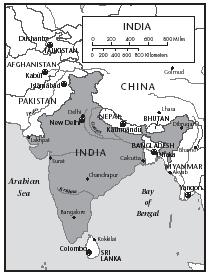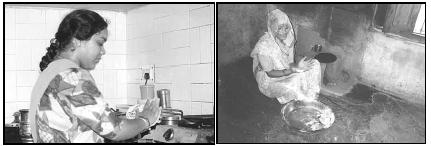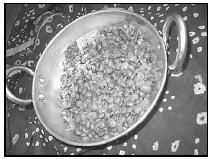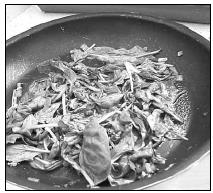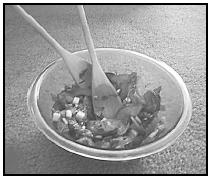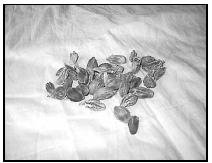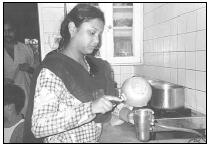Bengali cuisine is a style of food preparation originating in Bengal, a region in the eastern South Asia which is now divided between the Indian states of Tripura, Barak Valley of Assam and West Bengal and the independent country of Bangladesh. With an emphasis on fish and lentils served with rice as a staple diet, Bengali cuisine is known for its subtle (yet sometimes fiery) flavours, its confectioneries and desserts, and has perhaps the only indigenously developed multi-course tradition from South-Asia that is analogous with the likes of Japanese, French and Italian cuisine in structure.
Fish and meat
Fish is the dominant kind of meat, cultivated in ponds and fished with nets in the fresh-water rivers of the Ganges delta. Almost every part of the fish (except fins and innards) is eaten; the head and other parts are usually used to flavor curries. The head is often cooked with
dal or with cabbage.
More than forty types of mostly freshwater fish are common, including carp varieties like
rui (rohu), koi (climbing perch), the wriggling catfish family of tangra, magur, shingi and the pink-bellied Indian butter fish, the pabda
katla,
magur (catfish),
chingŗi (prawn or shrimp), as well as
shuţki (small dried sea fish).
Chingri could be of varieties -
kucho (varieties of shrimp), usual (prawns),
bagda (tiger prawns), and
galda (Scampi).

Shorshe Ilish, a dish of smoked hilsa with mustard seeds paste, has been an important part of both Bangladeshi and Bengali cuisine.
Salt water fish (not sea fish though) hilsa (
hilsa ilisha) is very popular among Bengalis, can be called an icon of Bengali cuisine.
Ilish machh (hilsa fish), which migrates upstream to breed is a delicacy; the varied salt content at different stages of the journey is of particular interest to the connoisseur, as is the river from which the fish comes - fish from the river Pôdda (Padma or Lower Ganges) in Bangladesh, for example, is traditionally considered the best. To some part of the community, particularly from West Bengal, Gangatic Ilish is considered as the best variety.
There are numerous ways of cooking fish depending on the texture, size, fat content and the bones. It could be fried, cooked in roasted, a simple spicy tomato based gravy (
jhol), or mustard based with green chillies (
shorshe batar jhaal), with
posto, with seasonal vegetables, steamed, steamed inside of plantain leaves, cooked with
doi (curd/yogurt), with sour sauce, with sweet sauce or even the fish made to taste sweet on one side, and savory on the other.
Ilish is said be cooked in 108 distinct ways
Chicken is a late entrant into Bengali cuisine relative to mutton.
Khashi, the meat of younger goats, is preferred.
VegetablesThe variety of fruits and vegetables that Bengal has to offer is incredible. A host of gourds, roots and tubers, leafy greens, succulent stalks, lemons and limes, green and purple eggplants, red onions, plantain, broad beans, okra, banana tree stems and flowers, green jackfruit and red pumpkins are to be found in the markets or anaj bazaar as popularly called.
Cereals
Bengali people are primarily rice eaters, and the rainfall and soil in Bengal lends itself to rice production as well. Many varieties of rice are produced from the long grain fragrant varieties to small grain thick ones. Rice is semi-prepared in some cases when it is sold as par-boiled, or in some cases as un-polished as well, still retaining the color of the husk. Rice is eaten in various forms as well - puffed, beaten, boiled and fried depending on the meal. The first two are used usually as snacks and the other as the main constituent in a meal. Lightly fermented rice is also used as breakfast in rural and agrarian communities.
Luchi (circular deep fried un-leavened bread) or
Porothha (usually triangular, multi-layered, pan fried, un-leavened bread) are also used as the primary food item on the table. It is considered that wheat based food came in from the north and is relatively new in advent. Both Luchi and Parothha could have stuffed versions as well, and the stuffing could vary from
dal, peas etc.
Pulses (or lentils) form another important ingredient of a meal. These
dals vary from
mushur đal (red lentils),
mug đal (mung beans),
kadhaier dal,
arhar dal' etc. and are used as an accompaniment to rice. Cooking medium and spices
Shorsher tel (mustard oil) is the primary cooking medium in Bengali cuisine although
Badam tel (groundnut oil) is also used, because of its high smoke point. Of late, the use of sunflower oil, soybean oil and refined vegetable oil, which is a mixture of soybean, kardi, and other edible vegetable oils, is gaining prominence. This later group is popularly known as "sada tel", meaning white oil, bringing out the contrast in color between the lightly-colored groundnut and the somewhat darker mustard oil and the other white oils. However, depending on type of food,
ghee (clarified butter) is often used, e.g., for making the dough or for frying bread.
mustard paste,
holud (turmeric),
poshto poppyseed),
ada (ginger),
dhonia (coriander, seeds and leaves) and
narikel (ripe coconut usually desiccated) are other common ingredients. 'The
pãch poron is a general purpose spice mixture composed of
radhuni (Carum roxburghianum seeds),
jeere (cumin),
kaalo jeere (black cumin, also known as nigella),
methi (fenugreek) and
mauri (anis). This mixture is more convenient for vegetarian dishes and fish preparations. In addition to the specific flavour and taste obtained by these combinations, behind the recipes, there has been a solid knowledge of the medicinal properties known in the traditional system of
aayurveda.
Instruments and utensils
Another characteristic of Bengali food is the use of a unique cutting instrument, the
bothi. (This instrument is also used in Maharashtra, where it is known as
vili and in Andhra Pradesh, known as
kathi peeta (
kathi = knife and
peeta = platform) ). It is a long curved blade on a platform held down by foot; both hands are used to hold whatever is being cut and move it against the blade. The method gives excellent control over the cutting process, and can be used to cut anything from tiny shrimp to large pumpkins. Knives are rare in a traditional Bengali kitchen.
A
korai (wok) is a universal cooking vessel for most Bengali food, for making sauces, frying/stir-frying etc.
Dekchi (a flat bottomed pan) is used generally for larger amounts of cooking or for making rice. The dekchi comes with a thin flat lid which is used also to strain out the starch while finishing up cooking rice. The other prominent cooking utensil is a
haandi, which is a round bottomed pot like vessel. All the three mentioned vessels come in various sizes and in various metals and alloys.
Silverware, as expected, is not part of traditional Bengali cookery. A flat metal spatula,
khonti is used often, along with
haatha (scoop with a long handle),
jhaanjri (round shaped sieve like spatula to deep fry food), the sharashi (pincers to remove vessels from the fire), the ghuntni (wooden hand blender) for puréeing dal and the old wooden chaki belon (round pastry board and rolling pin), sil nora (grinding stone) is also used.
Preparation and cutting
Bengali cuisine is rather particular in the way vegetables and meat (or fish) are prepared before cooking. Some vegetables are used unpeeled, in some preparations fish is used un-skinned in contrast as well. However, in most dishes vegetable are peeled, and fish scaled and skinned.
In many cases the main ingredients are lightly marinated with salt and turmeric (also an anti-bacterial and anti-septic). Vegetables are to be cut in different ways for different preparations. Dicing, Julienne, strips, scoops, slices, shreds are common and one type of cut vegetables can not replace another style of cutting for a particular preparation. Any aberration is frowned upon. For example, in
Aaloo-kumror Chhakka the potatoes and gourds must be diced not shredded and if they are shredded it will be
ghonto and not
chhakka.
Cooking styles
In East Bengal, now Bangladesh, the culinary style developed rather independently; it was not greatly influenced by the rest of India and Southeast Asia because of the difficult geography of the Ganges delta. Some characteristics stand out: fresh-water fish, beef (only for Muslims), the extensive use of parboiled rice, and much spicier food (some of the hottest dishes in the world). Floods are common in the region, so there is an extensive use of root vegetables and dried fish (
shuţki). Milk and dairy products, so widely used in the neighboring India, are not as common here; the geography prevents large-scale dairy farming, thus making dairy products an expensive indulgence. Although, some food calls for curd/yogurt or ghee. However, sweets do contain milk and dairy products as well as jaggery and rice paste.
As you move eastwards, anthropologically the people become more and more different, and the language takes a different tone and flavour all together. The far eastern parts are closer culturally to Burma than to India. In western parts of Bengal, more connected with the rest of India and dominated by the megacity of Kolkata since the late eighteenth century, the culinary style evolved to become different. The delta is thinner there, with fewer rivers and more open plains. There is significant commerce with the rest of India, leading to a flow of spices, ingredients and techniques and more importantly culture. The presentations are more elaborate and a significant feature of the cuisine is a vast array of sweets based on milk and sugar as part of tradition. While fresh-water fish is still common, mutton is more common among the Muslim population than beef and dried fish. Wheat makes its appearance alongside rice, in different types of breads such as
luchi,
kochuri and
pôroţa. For the former however, flour, not wheat is used. Mustard paste is extensively used, and so is mustard oil. There's a greater use of coconut, both in cooking and in desserts.
Prosperity and urbanization also led to the widespread use of professional cooks who introduced complex spice mixtures and more elaborate sauces, along with techniques such as roasting or braising. Also introduced around this time, probably as a consequence of increased urbanization, was a whole new class of snack foods. These snack foods are most often consumed with evening tea. The tea-time ritual was probably inspired by the British, but the snacks most popular are Kolkata -
chaţ,
kachori,
beguni,
mochaar chop,
samosa,
phuluri and the ever-popular jhal-muri also referred to as bhelpuri . Puchka is the ever-popular street food.
Common Bengali Cooking Styles
- Aum-bol : A sour dish made either with several vegetables or with fish, the sourness being produced by the addition of tamarind pulp.
- Bhaja : Anything fried, either by itself or in batter.
- Bhapa : Fish or vegetables steamed spices. A classic steaming technique is to wrap the fish in banana leaf to give it a faint musky, smoky scent.
- Bhorta : Any vegetable, such as potatoes, beans, sour mangoes, papaya, pumpkins or even dal, first boiled whole and then mashed and seasoned with red shallot, fresh chilli, mustard oil/ghee and spices.
- Bhuna : Meaning fried for a long time with ground and whole spices over high heat until shallot/garlic/ginger have dissolved into a thick paste. Usually applied to meat and some shellfish.
- Chorchori : Usually a vegetable dish with one or more varieties of vegetables cut into longish strips, sometimes with the stalks of leafy greens added, all lightly seasoned with spices like mustard or poppy seeds and flavoured with a pouron. The skin and bone of large fish like bhetki (Red snapper (fish)) or chitol can be made into a chachchari called kata-chachchari, kata, meaning fish-bone.
- Chhyonchra : A combination dish made with different vegetables, portions of fish head and fish oil (entrails).
- Chhenchki : Tiny pieces of one or more vegetable - or, sometimes even the peels (of potatoes, laou, pumpkin or potol for example) - usually flavored with pach-pouron, whole mustard seeds or kalo jira. Chopped shallot and garlic can also be used, but hardly any ground spices.
- Dalma : Mixed vegetables or eggs, cooked in a medium thick gravy seasoned with ground spices, especially gorom moshla and a touch of ghee.
- Dom : Vegetables, especially potatoes, or meat, cooked over a covered pot containing water, slowly over a low heat, slightly steaming.
- Dolma : A vegetable, 'patol', stuffed with fish boiled, de-boned, then prepared with garam masala, ginger and onions (alternately coconut-vegetable stuffing is used)
- Ghonto : Different complementary vegetables (e.g., cabbage, green peas, potatoes or banana blossom, coconut, chickpeas) are chopped or finely grated and cooked with both a pouron and ground spices. Dried pellets of dal are often added to the ghonto. Ghee is commonly added at the end. Non-vegetarian ghontos are also made, with fish or fish heads added to vegetables. The famous murighonto is made with fish heads cooked in a fine variety of rice. Some ghantos are very dry while others a thick and juicy.
- Jhal : Literally, hot. A great favorite in West Bengali households, this is made with fish or shrimp or crab, first lightly fried and then cooked in a light sauce of ground red chilli or ground mustard and a flavoring of pach-pouron or kalo jira. Being dryish, it is often eaten with a little bit of dal pored over the rice.
- Jhol : A light fish or vegetable stew seasoned with ground spices like ginger, cumin, coriander, chilli, and turmeric with pieces of fish and longitudinal slices of vegetables floating in it. The gravy is thin yet extremely flavorful. Whole green chillies are usually added at the end and green coriander leaves are used to season for extra taste.
- Kalia : A very rich preparation of fish, meat or vegetables using a lot of oil and ghee with a sauce usually based on ground ginger and shallot paste and gorom moshla.
- Koufta (or Boras) : Ground meat or vegetable croquettes bound together by spices and/or eggs served alone or in savory gravy.
- Korma : A term of Mughali origin, meaning meat or chicken cooked in a mild yoghurt based sauce with ghee instead of oil. People of Southern Bangladesh are known to add coconut milk to many of their dishes and Korma is no exception.
- Poura : Literally, burnt. Vegetables are wrapped in leaves and roasted over a wood or charcoal fire. Some, like aubergines (eggplants), are put directly over the flames. Before eating the roasted vegetable is mixed with oil and spices.
- Torkari : A general term often used in Bengal the way `curry' is used in English. The word first meant uncooked garden vegetables. From this it was a natural extension to mean cooked vegetables or even fish and vegetables cooked together.
Culinary Influences
Bengali food today has some broad (though not so distinct) variations - Traditional, Mughal, Anglo-Indian and Chinese.
Mughal influence
Islam arrived in Bengal probably around the mid-thirteenth century, coming into force with the penetration of the Muslim rulers from the northwest. Dhaka (the present-day capital of Bangladesh), in particular, expanded greatly under Mughal rule. The partition of India in 1947 resulted in a large migration of people to and from present-day Bangladesh, resulting in a much stronger divide along religious lines. Bangladesh today shows a much greater Muslim influence than West Bengal.
The influence on the food was top-down, and more gradual than in many other parts of India. This led to a unique cuisine where even the common man ate the dishes of the royal court, such as
biryani,
korma and
bhuna. The influence was reinforced in the Raj
[disambiguation needed] era, when Kolkata became the place of refuge for many prominent exiled Nawabs, especially the family of Tipu Sultan from Mysore and Wajid Ali Shah, the ousted Nawab of Awadh. The exiles brought with them hundreds of cooks and
masalchis (spice mixers), and as their royal patronage and wealth diminished, they interspersed into the local population. These highly accomplished cooks came with the knowledge of a very wide range of spices (most notably
jafran saffron and mace), the extensive use of ghee as a method of cooking, and special ways of marinating meats.
In Bangladesh, this food has over time become the staple food of the populace. In West Bengal, however, this has remained more than the other categories, the food of professional chefs; the best examples are still available at restaurants. Specialties include
chap (ribs slow cooked on a tawa),
rezala (meat in a thin yogurt and cardamom gravy) and the famous
kathi roll (kebabs in a wrap). The local population absorbed some of the ingredients and techniques into their daily food, resulting in meat-based varieties of many traditional vegetarian dishes, but by and large the foods remained distinct.
The Mughal influence is most distinct in preparations involving meat especially mutton. However, even chicken and other meats became more prevalent. The influence was also seen in desserts; traditional desserts were based on rice pastes and jaggery but under the Mughal influence moved towards significantly increased use of milk, cream and sugar along with expensive spices such as cardamom and saffron.
Anglo-Indian or Raj cuisine
Anglo-Indian food isn't purely the influence of the British; Bengal was once the home of a French colony, and also hosted populations of Portuguese, Dutch, Armenians and Syrians. These collective western influences are seen in the foods created to satisfy the tastes of the western rulers. The result is a unique cuisine, local ingredients adapted to French and Italian cooking techniques—characterized by creamy sauces, the restrained use of spices and new techniques such as baking. English and Jewish bakers such as Flury's and Nahoum's dominated the confectionery industry which migrated from British tables to everyday Bengali ones, resulting in unique creations such as the
pêţis (savory turnovers, from the English "pasty"). Another enduring contribution to Bengali cuisine is
pau ruţi, or Western-style bread. Raj-era cuisine lives on especially in the variety of finger foods popularized in the 'pucca' clubs of Kolkata, such as
mutton chop,
kabiraji cutlet or
fish orly.
The British also influenced food in a somewhat different way. Many British families in India hired local cooks, and through them discovered local foods. The foods had to be toned down or modified to suit the tastes of the 'memsahibs'. The most distinct influence is seen in the desserts, many of which were created specifically to satisfy the British - most notably the very popular sweet
leđikeni named after the first Vicereine Lady Canning; it is a derivative of the
pantua created for an event hosted by her.
Chinese food
The Chinese of Kolkata originally settled into a village called Achipur south of Kolkata in the late 18th century, later moving into the city and finally into its present home in Tangra at the eastern edge of Kolkata, which still houses over 100,000 ethnic Chinese
[citation needed]. The Chinese of Kolkata form a substantial and successful community with a distinct identity. With this identity came Chinese food, available at almost every street corner in Kolkata. They were mostly Cantonese tradesmen and sailors, bringing with them monosodium glutamate and sweet corn. The cuisine is characterized as much by what is missing - mushrooms, for instance, are not found in Bengal - as by what is there, such as a far greater use of pork than any of the other cuisines. As the Chinese opened restaurants for Bengalis, they spiced up the bland Cantonese sauces with sliced chillies and hot sauces, creating unique dishes such as
Chicken sweet corn soup,
Chinese fried rice,
Chowmein (noodles),
Chilli Chicken and
Manchurian dishes.
Indian Chinese food was given a second boost when a large number of Tibetans migrated into Indian Territory, following the 14th Dalai Lama's flight. Tibetans brought with them their own delicacies to add to this genre, such as the very popular momo (a kind of dumpling) or thukpa (a hearty noodle soup). Tibetans and Nepali immigrants also found ready employment in kitchens as 'Chinese' cooks because of their looks, and helped power the millions of eateries that serve this unique fusion on every street in Kolkata.
Bangladesh also hosts a large number of Chinese restaurants. In Dhaka, the phrase
Chai-niz khaowa (literally 'to eat Chinese food') often simply means 'to eat out (at a restaurant)', as Chinese cuisine was the first widely-available food in Dhaka eateries. As with Indian Chinese food, Chinese food in Bangladesh has evolved much from its Cantonese roots, with greater usage of chili, soy sauce, lemon and peanut than Indian Chinese and the use of other spices native to East Bengal. Unlike Indian Chinese food, Bangladeshi Chinese food still retains the use of mushrooms and although generally hotter, is much sweeter than its Indian counterparts.
The influence of this unique cuisine cannot be overstated; it's available in every town in India and Bangladesh as Chinese food. Bengali immigrants to other countries have started carrying this abroad as well; Indian Chinese restaurants have appeared in many places in the United States.
Bengali meals
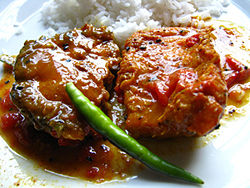
A traditional fish meal called, Macher Jhol (Literally translated to Fish in Gravy).
The Bengalis are great food lovers and take pride in their cuisine. In fact so obsessed are they about food, that the man of the house goes to the market daily to buy a fresh supply of fish which is a must in their daily menu. The most common variety of fish that the Bengalis eat are the Hilsa, Bekti, Rohu and among the shell fish the Prawns. The medium of cooking is mustard oil which adds on its own pungency. Another very important item of Bengali cuisine is the variety of sweets or mishti as they call them. Most of them are milk based and are prepared from chaana (paneer as it is popularly known). The most popular among the Bengali sweets are the Rosogolla, Sandesh, Pantua and Mishti Doi and these four sweets are a must at every wedding besides some other sweets, which may vary as per individual choice. A meal, for the Bengali, is a ritual in itself even if it only boiled rice and lentils (dal bhat), with of course a little fish. Bengalis, like the French, spend not only the great deal of time thinking about the food but also on its preparation and eating. Quips like “Bengalis live to eat” and “Bengalis spend most of their income on food” are not exactly exaggerated. The early morning shopping for fresh vegetables, fish etc. is the prerogative of the head of the family, even in affluent household, because he feels that he alone can pick up the best at a bargain price. The Bengalis are very particular about the way and the order in which the food should be served. Each dish is to be eaten separately with a little rice so that the individual flavors can be enjoyed. The first item served may be a little ghee which is poured over a small portion of rice and eaten with a pinch of salt. Then come the bitter preparation, shukto, followed by lentils or dals, together with roasted or fried vegetables (bhaja or bharta). Next come the vegetable dishes, the lightly spiced vegetables, chenchki, chokka, followed by the most heavily spiced dalna, ghonto and those cooked with fish. Finally the chicken or mutton, if this being served at all. Chaatni comes to clear the palate together with crisp savory wafers, papor. Dessert is usually sweet yogurt (mishti doi). The meal is finally concluded with the handing out of betel leaf (paan), which is considered to be an aid to digestion and an astringent. Traditionally the people here eat seated on the floor, where individual pieces of carpet, called asans, are spread for each person to sit on and the meal is served on a large gun-metal or silver plate (thala) and the various items of food are placed in bowls (batis) around the top of the thala, running from right to left. Rice is mounded and placed on the middle of the thala, with a little salt, chilies and lime placed on the upper right hand corner. They eat with the fingers of the right hand and strict etiquette is observed with regard to this. The typical Bengali fare includes a certain sequence of food - somewhat like the courses of Western dining. Two sequences are commonly followed, one for ceremonial dinners such as a wedding and the day-to-day sequence. Both sequences have regional variations, and sometimes there are significant differences in a particular course between West Bengal and Bangladesh.
At home, Bengalis traditionally ate without silverware:
kaţa (forks),
chamoch (spoons), and
chhuri (knives) gradually finding use on Bengali tables in urban areas. Most Bengalis eat with their right hand, mashing small portions of meat and vegetable dishes with rice and in some cases, lentils. In rural areas, Bengalis traditionally eat, sitting on the floor with a large banana or plantain leaf serving as the plate or plates made from sal leaves sown together and dried.
The elaborate dining habits of the Bengalis were a reflection of the attention the Bengali housewife paid to the kitchen. In modern times, thanks to Western influence, this is rarely followed anymore. Courses are frequently skipped or combined with everyday meals. Meals were usually served course by course to the diners by the youngest housewives, but increasing influence of nuclear families and urbanization has replaced this. It is now common to place everything on platters in the centre of the table, and each diner serves him/herself. Ceremonial occasions such as weddings used to have elaborate serving rituals, but professional catering and buffet-style dining is now commonplace. The traditions are far from dead, though; large family occasions and the more lavish ceremonial feasts still make sure that these rituals are observed.
The slightly elaborate daily meal
The foods of a daily meal are usually simpler, geared to balanced nutrition and makes extensive use of vegetables. The courses progress broadly from lighter to richer and heavier and goes through various tastes and taste cleansers. Rice remains common throughout the meal and is the main constituent of the meal, until the
chaţni (chutney) course.
First course/Starter
The starting course is made from bitter vegetables or herbs, often deep fried in oil or steamed with cubed potatoes. Portions are usually tiny - a spoonful or so to be had with rice - and this course is considered to be both a palate-cleanser and of great medicinal value. The ingredients used for this course change seasonally, but commonly used ones are
kôrolla or
uchhe(forms of bitter gourd) which are available nearly all year round, or tender
nim leaves in spring.
In West Bengal, a thick soupy mixture of vegetables in a ginger-mustard sauce called
shukto usually follows the bitter starting course, but sometimes replaces it as a starter altogether. Eaten in much bigger portions,
Shukto is usually eaten in summer. It is a complex dish, featuring a fine balance of many different tastes and textures and is often a critical measure of a Bengali housewife's abilities in the kitchen. However, it is not particularly popular in Bangladesh.
Shaak
The first course is then followed by
shaak (leafy vegetables) such as spinach,
palong chard,
methi fenugreek, or amaranth. The
shaak can be steamed or cooked in oil with other vegetables such as
begun (eggplant). Steamed
shaak is sometimes accompanied by a sharp paste of mustard and raw mango pulp called
Kasundi.
Dal
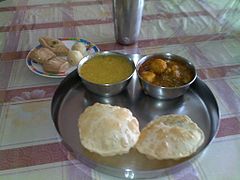
Luchis with alur dom, cholar dal and sondesh.
The đal course is usually the most substantial course, especially in West Bengal. It is eaten with a generous portion of rice and a number of accompaniments. Common accompaniments to đal are
aaloo bhaate (potatoes mashed with mustard oil), and
bhaja (fritters).
Bhaja literally means 'deep-fried'; most vegetables are good candidates but
begun (aubergines),
kumro (pumpkins), or
alu (potatoes) like french fries, or shredded and fried,
uchhe,
potol pointed gourdare common.
Machh bhaja (fried fish) is also common, especially
rui (rohu) and
ilish (hilsa) fishes.
Bhaja is sometimes coated in a
beshon (chickpea flour) and
posto (poppyseed) batter. A close cousin of
bhaja is
bôra or deep-fried savoury balls usually made from
posto (poppyseed) paste or coconut mince. Another variant is fried pointed gourd as
potoler dorma with roe stuffing. Cholar Dal is often eaten with luchis.
Another accompaniment is a vegetable preparation usually made of multiple vegetables stewed slowly together without any added water.
Labra,
chorchori,
ghonto, or
chanchra are all traditional cooking styles. There also are a host of other preparations that do not come under any of these categories and are simply called
tôrkari - the word merely means 'vegetable' in Bengali. Sometimes these preparations may have spare pieces of fish such as bits of the head or gills, or spare portions of meat. A
charchari is a vegetable dish that is cooked without stirring, just to the point of charring.
Pickles such as raw mangoes pickled in mustard oil and spices or sweet and tangy tamarind picckles are also served with the dal course.
Main course
The next course is the fish course. Famous fish dishes include
machher jhol,
tel koi,
pabda machher jhal,
Doi machh,
Chingri machh (shrimp)
malai curry, and
bhapa ilish (steamed hilsa).
Doi Maach Recipe: First the fish needs to be seasoned with salt and turmeric and then fried in mustard oil. Then fry some grated onions, add ginger and garlic paste, cumin powder, coriander powder, garam masala powder and termeric and saute. Add yogurt and salt and slow cook until the spices blend to form a smooth mixture. Add fish and slow cook for 5 to 7 minutes. Serve hot with steamed white rice.
Additional main course
Then comes the meat course. The divide among the Bengalis of Bangladesh and West Bengal is most evident when it comes to the meat course. Meat is readily consumed in urban parts of Bangladesh and some consider it the meal's main course. Beef in particular is very popular in Bangladesh, and it is a must in most of the feasts and banquets across the country. Because the consumption of beef is prohibited among Bengali Hindu communities,
Khashi mutton or goat meat is traditionally the meat of choice in West Bengal, but
murgi chicken and
đim eggs are also commonly consumed. At the time of Partition, it was rare for caste Hindus to eat chicken or even eggs from hens, choosing rather duck eggs if eggs were to be consumed. Although it is debatable as to whether chicken is more popular than
khashi in West Bengal today, the proliferation of poulty farms and hatcheries makes chicken the cheaper alternative.
Chutney
Next comes the chutney course, which is typically tangy and sweet; the chutney is usually made of
am mangoes, tomatoes,
anarôsh pineapple,
tetul tamarind,
pepe papaya, or just a combination of fruits and dry fruits. The chutney is also the move towards the sweeter part of the meal and acts also as a palate cleanser, similar to the practice of serving sorbet in some Western cuisines.
Papoŗ (papadum), a type of wafer, thin and flaky, is often made of đal or potatoes or
shabu (tapioca) and is a usual accompaniment to the chutneys.
In Bangladesh, chutney is usually eaten during the đal course, and no separate course is dedicated to chutney.
Desserts
The last item before the sweets is Doi or yoghurt.It is generally of two varieties, either natural flavour and taste or Mishti Doi - sweet yoghurt, typically sweetened with charred sugar. This brings about a brown colour and a distinct flavour. Like the fish or sweets mishti doi is typically identified with Bengali cuisine.
In a daily meal it is likely that some of the courses might get missed, for instance the 'Shak',the additional course, Chutney and Papor. In some cases, the dessert might be given a miss as well. The courses overall are the same at home or at a social function (e.g. marriage fest). Rice, which is the staple across the meal gets replaced by 'loochi'or 'radhaballavi' i.e., loochi stuffed with dal or mashed green peas. Interesting thing to note is that the replacement is a relatively recent phenomenon and has been seen in practice only from about early 20th century.
Mishţi (sweets)
Sweets occupy an important place in the diet of Bengalis and at their social ceremonies. It is an ancient custom among both Hindu and Muslim Bengalis to distribute sweets during festivities. The confectionery industry has flourished because of its close association with social and religious ceremonies. Competition and changing tastes have helped to create many new sweets, and today this industry has grown within the country as well as all over the world.
The sweets of Bengal are generally made of sweetened cottage cheese (
chhana), unlike the use of
khoa (reduced solidified milk) in Northern India. Additionally, flours of different cereals and pulses are used as well. Some important sweets of Bengal are:
Shôndesh
Made from sweetened, finely ground fresh chhana (cottage cheese), shôndesh in all its variants is among the most popular Bengali sweets. The basic shôndesh has been considerably enhanced by the many famous confectioners of Bengal, and now a few hundred different varieties exist, from the simple
kachagolla to the complicated
abar khabo,
jôlbhôra or
indrani. Another variant is the
kôrapak or hard mixture, which blends rice flour with the paneer to form a shell-like dough that last much longer. Note that Shondesh is also the name of a sweet pancake-like snack eaten in Bangladesh and West Bengal (where it is called malpua). What West Bengal call "shondesh" is a type of halwa in Bangladesh. Shondesh also means "news" in Hindi.
Rôshogolla
Rôshogolla is one of the most widely consumed sweets. The basic version has many regional variations. Though this sweet has been primarily borrowed from Odisha, Nabin Chandra Das is considered to have "invented" it in Bengal. Rôshogolla is one of the three most prominent trademark of Bengali culture (along with Rabindranath Tegore and the festival of Durga Puja) and probably the face of Bengali cuisine to people outside Bengal (along with fish and stereotypical
posto or poppyseed).
Laddu
Laddu is a very common sweet in Bangladesh and West Bengal, especially during celebrations and festivities.
Pantua
Pantua is somewhat similar to the rôshogolla, except that the cottage cheese balls are fried in either
ghee (clarified butter) or oil until golden or deep brown before being put in syrup. There are similar tasting, but differently shaped versions of the Pantua e.g. Langcha (cylindrical) or Ledikeni. Interestingly, the latter was created in honour of Countess Charlotte Canning (wife of the then Governor General to India Charles Canning) by Bhim Nag, a renowned sweets maker in Kolkata.
Chômchôm
Chômchôm (especially from Porabari, Tangail District in Bangladesh) goes back about 150 years. The modern version of this sweet(চমচম)was inspired by porabari of Tangail district in Bangladesh. It was then further modernised by his grandson, islam. This oval-shaped sweet is reddish brown in colour and has a denser texture than the rôshogolla. It can also be preserved longer. Granules of
maoa or dried milk can also be sprinkled over chômchôm.
Piţha or pithe
In both Bangladesh and West Bengal, the tradition of making cakes, locally known as
piţha, still flourishes. They are usually made from rice or wheat flour mixed with sugar, jaggery, grated coconut etc. Piţhas are usually enjoyed with the sweet syrups of
khejurer gur (date tree molasses). They're usually fried or steamed; the most common forms of these cakes include
bhapa piţha (steamed),
pakan piţha (fried), and
puli piţha (dumplings), among others. The other common pithas are
chandrapuli,
gokul,
pati shapta,
chitai piţha,
aski pithe,
muger puli and
dudh puli. The Pati Shapta variety is basically a thin-layered rice-flour pancake turnover with a milk-custard creme-filling. In urban areas of Bangladesh and West Bengal most restaurants hold Pitha-festivals sometime during the winter months.
The celebration of the Piţha as a traditional sweet coincides with the Winter Harvest festival in rural Bangladesh and West Bengal. The harvest is known as 'Nabanno' -- (literally 'new sustenance') and calls for not only rare luxuries celebrating food and sweets but also other popular and festive cultural activities like Public Dramas at night and Open Air Dance Performances.
Other sweets
Several varieties of yoghurts such as
mishţi doi, custards, and rice pudding (
khir or
firni) are also popular in both Bangladesh and West Bengal.
Shôndesh,
chhanar jileepi,
kalo jam,
darbesh,
raghobshai,
paesh,
bundiya ,
nalengurer shôndesh,
shor bhaja,
langcha and an innumerable variety are just a few examples of sweets in Bengali cuisine.
Snacks
Muŗi
Muŗi (puffed rice) is made by heating sand in a pot, and then throwing in grains of rice. The rice may have been washed in brine to provide seasoning. The rice puffs up and is separated from the sand by a strainer. Muŗi is very popular and is used in a wide variety of secular and religious occasions, or even just munched plain. Muri is also often used as a replacement for or in combination with regular rice.
A variant of muŗi is khoi, which is flattened puffed rice. Both varieties are used to make many different snack foods.
Jhal-Muŗi
One of the most popular and iconic snack foods of Bengal,
jhal literally means 'hot' or 'spicy'. Jhal-muŗi is puffed rice with spices, vegetables and raw mustard oil. Depending on what is added, there are many kinds of jhal-muŗi but the most common is a
bhôrta made of chopped onion,
jira roasted ground cumin,
bitnoon black salt
lôngka /
morich chilis (either
kacha 'ripe' or
shukna 'dried'), mustard oil, and
dhone pata (fresh coriander leaves). and ( mudhi ) also.
Moa
A moa is made by taking muri with gur (jaggery) as a binder and forming it into a ball. Another popular kind of moa is
Joynagorer moa, a moya particularly made in Joynagor from a district of West Bengal which uses khoi and a sugar-milk-spices mixture as binder.Moa is mainly found during the winter season.
Glossary
adapted from content by Sutapa Ray- Ambal: A sour dish made either with several vegetables or with fish, the sourness being produced by the addition of tamarind pulp.
- Biryani: Fragrant dish of long-grained aromatic rice combined with beef, mutton, or chicken and a mixture of characteristic spices. Sometimes cooked in sealed containers (dum biriyani).
- Bhaja or Bhaji: Anything fried, either by itself or in batter.
- Bhapa: Fish or vegetables steamed with oil and spices. A classic steaming technique is to wrap the fish in banana leaf to give it a faint musky, smoky scent.
- Bhate: ('steamed with rice') any vegetable, such as potatoes, beans, pumpkins, or even dal, first boiled whole and then mashed and seasoned with mustard oil or ghee and spices. Traditionally the vegetables were placed on top of the rice; they steamed as the rice was being boiled.
- Bhuna: A term of Urdu origin, and applies to meat cooked in spices for a long time without water. The spices are slow-cooked in oil (bhunno). The spices first absorb the oil, and when fully cooked release the oil again.
- Bora: See Kofta
- Chachchari: Usually a vegetable dish with one or more varieties of vegetables cut into longish strips, sometimes with the stalks of leafy greens added, all lightly seasoned with spices like mustard or poppy seeds and flavoured with a phoron. The skin and bone of large fish like bhetki (red snapper) or chitol can be made into a chachchari called kanta-chachchari, kanta, meaning fish-bone.
- Chhanchra: A combination dish made with different vegetables, portions of fish head and fish oil (entrails).
- Chechki: Tiny pieces of one or more vegetable - or, sometimes even the peels (of potatoes, lau, pumpkin or patol for example) - usually flavored with panch phoron or whole mustard seeds or kala jeera. Chopped onion and garlic can also be used, but hardly any ground spices.
- Dalna: Mixed vegetables or eggs, cooked in medium thick gravy seasoned with ground spices, especially garom mashla and a touch of ghee.
- Dam or Dum: Vegetables (especially potatoes), meat or rice (biriyanis) cooked slowly in a sealed pot over a low heat.
- Dolma or Patoler Dolma: The name is coming from Turkey, but the food is different. The vegetable Patol is stuffed either with a combination of grated coconut, chickpeas, etc. or more commonly with fish and then fried. The fish is boiled with turmeric and salt, then bones are removed and then onion, ginger and garam masala are fried in oil and boiled fish is added and churned to prepare the stuffing.
- Ghonto: Different complementary vegetables (e.g., cabbage, green peas, potatoes or banana blossom, coconut, chickpeas) are chopped or finely grated and cooked with both a phoron and ground spices. Dried pellets of dal (boris) are often added to the ghanto. Ghee is commonly added at the end. Non-vegetarian ghantos are also made, with fish or fish heads added to vegetables. The famous murighanto is made with fish heads cooked in a fine variety of rice. Some ghantos are very dry while others a thick and juicy.
- Jhal: Literally, 'hot'. A great favorite in West Bengali households, this is made with fish or shrimp or crab, first lightly fried and then cooked in a light sauce of ground red chilli or ground mustard and a flavoring of pãch-phoron or kala jira. Being dryish it is often eaten with a little bit of dal pored over the rice.
- Jhol: A light fish or vegetable stew seasoned with ground spices like ginger, cumin, coriander, chili, and turmeric with pieces of fish and longitudinal slices of vegetables floating in it. The gravy is thin yet extremely flavorful. Whole green chilis are usually added at the end and green coriander leaves are used to season for extra taste. This term is also used to refer to any type of stew in meat, fish or vegetable dishes.
- Kalia: A very rich preparation of fish, meat or vegetables using a lot of oil and ghee with a sauce usually based on ground ginger and onion paste and garom mashla.
- Khichuŗi: Rice mixed with Moong Dal or Masoor dal(kinds of lentil) and vegetables, and in some cases, boiled or fried eggs. Usually cooked with spices and turmeric powder.
- Kofta: Ground meat or vegetable croquettes bound together by spices and/or eggs served alone or in savory gravy.
- Korma: Another term of Urdu origin (literally 'braised with onions), meaning meat or chicken cooked in a mild onion and yoghurt sauce with ghee.
- Luchi: Small round unleavened bread fried in oil.
- Panch phoran: A spice mixture of consisting of five whole seeds used in equal proportions and fried in oil or ghee. The spices cam vary, but the mixture usually includes cumin, fennel or anise, nigella, fenugreek, and either wild celery (radhuni) or black mustard seeds.
- Pôroţa: Bread made from wheat flour and fried in the oven until golden-brown.
- Paturi: Typically fish, seasoned with spices (usually shorshe) wrapped in banana leaves and steamed or roasted over a charcoal fire.
- Polau (See Pilaf): Fragrant dish of rice with ghee, spices and small pieces of vegetables. Long grained aromatic rice is usually used, but some aromatic short grained versions such as Kalijira or Gobindobhog may also be used.
- Pora: The word literally means charred. Vegetables are wrapped in banana leaves and roasted over a wood, charcoal or coal fire. Some vegetables with skin such as begun, are put directly on the flame or coals. The roasted vegetable is then mixed with onions, oil and spices.
- Ruţi: Unleavened bread made in a tawa and puffed over an open flame.
- Tôrkari: A general term often used in Bengal the way `curry' is used in English (it is speculated to be one of the origins of curry). Originally from Persian, the word first meant uncooked garden vegetables. From this it was a natural extension to mean cooked vegetables or even fish and vegetables cooked together.



